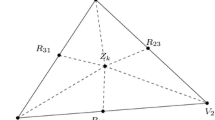Abstract
We develop a scheme for constructing G 1 triangular spline surfaces of arbitrary topological type. To assure that the scheme is local and singularity-free, we analyze the selection of scalar weight functions and the construction of the boundary curve network in detail. With the further requirements of interpolating positions, normals, and surface curvatures, we show that the minimum degree of such a triangular spline surface is 6. And we present a method for constructing boundary curves network, which consists of cubic Bézier curves. To deal with certain singular cases, the base mesh must be locally subdivided and we proposed an adaptive subdivision strategy for it. An application of our G 1 triangular spline surfaces to the approximation of implicit surfaces is described. The visual quality of this scheme is demonstrated by some examples.
Similar content being viewed by others
References
Bloomenthal J (1994) An implicit surface polygonizer. In: Graphics gems IV, Academic Press, San Diego, pp 324–349
Boehm W, Prautzsch H, Arner P (1987) On triangular splines. Constr Approx 3: 157–167
de Boor C, Höllig K (1982) B-splines from parallelepipeds. J d’Anal Math 42: 99–115
de Boor C, Höllig K, Sabin MA (1987) High accuracy geometric Hermite interpolation. Comp Aided Geom Des 4(4): 269–278
Cho DY, Lee KY, Kim TW (2006) Interpolating G 1 Bézier surfaces over irregular curve networks for ship hull design. Comp Aided Des 38(6): 641–660
Cho DY, Lee KY, Kim TW (2007) Analysis and avoidance of singularities for local G 1 surface interpolation of Bézier curve network with 4-valent nodes. Computing 79(2–4): 261–279
Du WH, Schmitt FJM (1990) On the G 1 continuity of piecewise Bézier surfaces: a review with new results. Comp Aided Des 22(9): 556–573
Farin G (1985) A modified clough-tocher interpolant. Comp Aided Geom Des 2(1–3): 19–27
Farin G (2002) Curves and surfaces for CAGD: a practical guide, chap 20, 5th edn. Morgan Kaufmann, San Francisco
Fünfzig C, Müller K, Hansford D, Farin G (2008) PNG1 triangles for tangent plane continuous surfaces on the GPU. In: GI’08: Proceedings of graphics interface 2008, pp 219–226
Garland M, Heckbert PS (1997) Surface simplification using quadric error metrics. In: Proceedings of ACM SIGGRAPH 1997, computer graphics proceedings. Annual conference series, pp 209–216
Garland M, Zhou Y (2005) Quadric-based simplification in any dimension. ACM Trans Graph 24(2): 209–239
Hagen H, Pottmann H (1989) Curvature continuous triangular interpolants. In: Mathematical methods in computer aided geometric design, Academic Press, San Diego, pp 373–384
Hahmann S, Bonneau GP (2000) Triangular G 1 interpolation by 4-splitting domain triangles. Comp Aided Geom Des 17(8): 731–757
Hoschek J, Lasser D (1993) Fundamentals of computer aided geometric design. AK Peters, Massachusetts
Jensen T (1987) Assembling triangular and rectangular patches and multivariate splines. In: Farin G (ed) Geometric modeling: algorithms and new trends, SIAM, Philadelphia, pp 203–220
Liu Y, Mann S (2008) Paramteric triangular Bézier surface interpolation with approximate continuity. In: SMP’08: Proceedings of the 2008 ACM symposium on solid and physical modeling, pp 381–387
Loop C (1994) A G 1 triangular spline surface of arbitrary topological type. Comp Aided Geom Des 11(3): 303–330
Mann S, Loop C, Lounsbery M, Meyers D, Painter J, DeRose T, Sloan K (1992) A survey of parametric scattered data fitting using triangular interpolants. In: Hagen H (ed) Curve and surface design, SIAM, Philadelphia, pp 145–172
Neamtu M, Pfluger PR (1994) Degenerate polynomial patches of degree 4 and 5 used for geometrically smooth interpolation in \({\mathbb{R}^3}\). Comp Aided Geom Des 11(4): 451–474
Nielson G (1987) A transfinite, visually continuous, triangular interpolant. In: Farin G (ed) Geometric modeling: algorithms and new trends, SIAM, Philadelphia, pp 235–246
Nocedal J, Wright S (1999) Numerical Optimization. Springer, New York
Patrikalakis NM, Maekawa T (2000) Shape interrogation for computer aided design and manufacturing, chap 8. Springer, Berlin
Peters J (1991) Smooth interpolation of a mesh of curves. Constr Approx 7(1): 221–246
Peters J (1995) Biquartic C 1-surface splines over irregular meshes. Comp Aided Des 27(12): 895–903
Peters J (1995) C 1-surface splines. SIAM J Numer Anal 32(2): 645–666
Peters J (2002) Geometric continuity. In: Farin G, Hoschek J, Kim MS (eds) Handbook of computer aided geometric design, Elsevier, Amsterdam, pp 193–227
Sabin M (1969) Conditions for continuity of surface normal between adjacent parametric surface. Tech. rep. VTO/MS/151, Dynamics and Maths Services Department, British Aircraft Corporation
Sabin M (1976) The use of piecewise forms of the numerical representation of shapes. Ph.D. thesis, Hungarian Academy of Sciences, Budapest, Hungary
Sabin M (2002) Subdivison surfaces. In: Farin G, Hoschek J, Kim MS (eds) Handbook of computer aided geometric design, Elsevier, Amsterdam, pp 309–326
Schaback R (1998) Optimal geometric Hermite interpolation of curves. In: Proceedings of the international conference on mathematical methods for curves and surfaces II, pp 417–428
Tong WH, Kim TW (2009) High-order approximation of implicit surfaces by G 1 triangular spline surfaces. Comput Aided Des 41(6): 441–445
Warren J, Weimer H (2001) Subdivision methods for geometric design: a constructive approach. Morgan Kaufmann, San Francisco
Watkins MA (1988) Problems in geometric continuity. Comp Aided Des 20(8): 499–502
Yvart A, Hahmann S, Bonneau GP (2005) Hierarchical triangular splines. ACM Trans Graph 24(4): 1374–1391
Author information
Authors and Affiliations
Corresponding author
Additional information
Communicated by C.H. Cap.
Rights and permissions
About this article
Cite this article
Tong, Wh., Kim, Tw. Local and singularity-free G 1 triangular spline surfaces using a minimum degree scheme. Computing 86, 235–255 (2009). https://doi.org/10.1007/s00607-009-0056-5
Received:
Accepted:
Published:
Issue Date:
DOI: https://doi.org/10.1007/s00607-009-0056-5
Keywords
- G 1 continuity
- Arbitrary topology
- Vertex enclosure constraint
- Singularity analysis
- Geometric Hermite interpolation
- Adaptive subdivision




